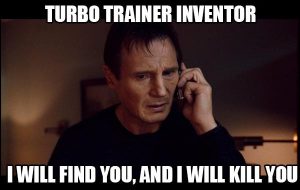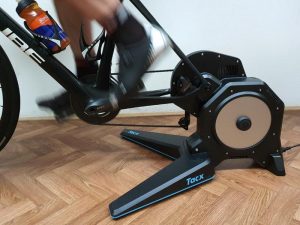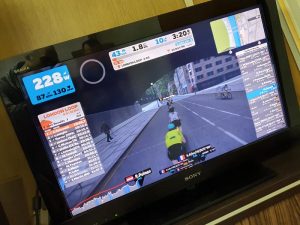If you can’t beat them – join them.
– Jim Henson
 Turbo trainer. It loves you and wishes you well, but rarely does anyone reciprocate its feelings. What’s the reason for it? Well, the reason is simple – boredom and huge amounts of sweat!
Turbo trainer. It loves you and wishes you well, but rarely does anyone reciprocate its feelings. What’s the reason for it? Well, the reason is simple – boredom and huge amounts of sweat!
Really, thinking of having to ride a turbo trainer gets most cyclists’ blood to boil. And yet, the majority of serious cyclists own one, because it is an incredibly useful and effective tool. But before we get into the positive aspects and ways of using a turbo trainer, let’s first make a difference between the so-called indoor or stationary fitness bikes, which we see in gyms or at homes of people who bought them full of enthusiasm, rode them once or twice and now they sit forgotten – and turbo trainers as an additional cycling equipment which allows you to ride your own bike (usually) indoors – and that is the type of turbo trainer that’s of our and the topic that we will cover in detail in this article.
We will also differentiate different types of trainers based on technological solutions, which are as follows:
- rollers, i.e. a set of rollers on which you practically ride a bicycle as you would on a road, creating resistance by yourself that increases with an increase of speed – and for the use of which you need to develop a special skill, because it is very easy to fall off them,
- turbo trainers with a roller that you drive with your rear wheel of your bicycle, which sits fixed and stable in the turbo trainer and the resistance is generated by one of the following:
—a) air turbine (hence the name turbo trainer),
—b) flywheel with magnetic or electromagnetic resistance,
—c) flywheel with fluid e.g. with progressive hydrodynamic resistance, - direct drive turbo trainers that completely replace your rear wheel and have a flywheel with electromagnetic resistance.
 All types of turbo trainers have their advantages and disadvantages. Air turbine trainers are outdated and very noisy, but they still allow you to spin the pedals. Some cheaper magnetic turbo trainers with cable for manual resistance adjustment generally behave unnaturally and often “slip”, i.e. they lead to riding in impulses, so they are not overly useful for more intense workouts. Fluid trainers do not have load adjustment, but the aforementioned fluid does it for you automatically, as it increases the resistance with an increase in speed and gives a feel that is very close to the feel you get on the road, while direct drive turbo trainers are conceptually a much better solution than classic turbo trainers. At some point, turbo trainers with electromagnets made an appearance on the scene and with the help of a controller you could even program your training in detail. With the development of technology, things went a few steps further in the possibilities and precision of control of the electromagnetic systems, so now, in addition to all other smart devices, we also have smart turbo trainers (but more on this topic at the end of the text).
All types of turbo trainers have their advantages and disadvantages. Air turbine trainers are outdated and very noisy, but they still allow you to spin the pedals. Some cheaper magnetic turbo trainers with cable for manual resistance adjustment generally behave unnaturally and often “slip”, i.e. they lead to riding in impulses, so they are not overly useful for more intense workouts. Fluid trainers do not have load adjustment, but the aforementioned fluid does it for you automatically, as it increases the resistance with an increase in speed and gives a feel that is very close to the feel you get on the road, while direct drive turbo trainers are conceptually a much better solution than classic turbo trainers. At some point, turbo trainers with electromagnets made an appearance on the scene and with the help of a controller you could even program your training in detail. With the development of technology, things went a few steps further in the possibilities and precision of control of the electromagnetic systems, so now, in addition to all other smart devices, we also have smart turbo trainers (but more on this topic at the end of the text).

Keep on rollin’
So, all of the above types of turbo trainers have the same goal and that is to allow you to ride your bike while being stationary, for one reason or another – and the reasons are plentiful:
1) Light aerobic rides during winter
Earlier, I wrote about winter preparations for cyclists, which include various aerobic activities. In the later period of preparations and/or when it is extremely cold outside even for walking or running, turbo trainer becomes your best friend and speeds up preparations for the return to the roads. Practically, there is a big difference if you do your first kilometers of the season out on road, as compared to doing it with having previously done a block of turbo trainer rides.
2) Tempo rides during the base riding period
We will deal with this theme in more detail in one of the following texts, but if winter comes late or turns out to be prolonged, rides of this type can be perfectly done solely on a turbo trainer or in combination with riding outside.
3) Very effective for high intensity interval training
You must have heard of the infamous interval training, which is highly technical training and as such can sometimes be done even more efficiently on a turbo trainer, in controlled environment, rather than on the road, especially if you do not have the appropriate terrain nearby.
4) Easy recovery rides
There will also be more talk about this in the near future, but basically – sometimes it is practically “not worth” getting ready and going outside for 30-60 minutes of light spinning and it is easier to just put on cycling shorts and shoes and jump on a turbo trainer instead.
5) Riding during breaks and in the early morning or late evening
If you work in strange shifts, have a break during the day or it simply gets dark by the time you get back home – then a turbo trainer is a great solution for you, because you will be able to do a planned training whenever you get time for it, during the day (or night).
6) Riding in dry and warm while it’s miserable outside
There’s well know saying: “There is no such thing as bad weather, only bad clothes”, which is true in principle and it’s even not a great deal to get soaked sometimes. However, if an extraordinary long rainy period happens – you have an option to either make a complete pause or return soaked from each ride or – you’ve guessed it – use a turbo trainer to overcome that period.
7) Possibility of riding with various injuries
Unfortunately, injuries are an integral part of cycling and during the recovery period or while having an injury with which you could ride a bike, but it is impractical or dangerous to do so on the road – there is a turbo trainer.
8) Doing a warm-up before a race or a gran fondo
Any type of ride that requires a readiness to go “full gas” from the word go, like a time trial ride, criterium races, riding straight uphill etc, is unimaginable without an adequate warm-up and there is no better way to do it than doing a controlled warm-up on a turbo trainer in the starting area, as you can see in the world’s biggest races.
9) It is ideal for adjusting the position on the bike
It is impossible to record and adjust the position of a cyclist on the road in a safe, efficient and practical way but you can film, analyze and experiment all you want on a turbo trainer at home. Professional bike fitting is basically done the same way.
10) Convenient as a bike stand and clothes hanger
OK, this is a little bit comical but true. If you have a spare bike sitting on your turbo trainer or you’ve simply parked your bike that way for a while – as it often happens to us men, we leave things at hand everywhere – therefore many garments very quickly end up on the bike, which has practical profiles for that purpose.
Ride Forrest, ride!
 Riding a classic turbo trainer requires a high level of concentration, motivation and even internal dialogue :). Most cyclists ride because they like to be outside and enjoy the landscapes and sights, so for most people riding a bike on a turbo trainer while staring at the wall is mind bogglingly boring. You ride for half an hour – take look at the clock and actually only 5 minutes have passed. You do it while watching a movie – the action seems very slow. Or you listen to music – a song never seems to end. And all that aside, the sweat breaks out of all your pores very quickly and unstoppably continues to flow until the end of the ride, if not longer. However, this is proverbially true only for the first couple of rides, because as with everything in life – the worst part is the start. You will soon get used to this procedure and time will flow faster and faster – and you will feel the progress, which will make you eager to return on the turbo trainer over and over again.
Riding a classic turbo trainer requires a high level of concentration, motivation and even internal dialogue :). Most cyclists ride because they like to be outside and enjoy the landscapes and sights, so for most people riding a bike on a turbo trainer while staring at the wall is mind bogglingly boring. You ride for half an hour – take look at the clock and actually only 5 minutes have passed. You do it while watching a movie – the action seems very slow. Or you listen to music – a song never seems to end. And all that aside, the sweat breaks out of all your pores very quickly and unstoppably continues to flow until the end of the ride, if not longer. However, this is proverbially true only for the first couple of rides, because as with everything in life – the worst part is the start. You will soon get used to this procedure and time will flow faster and faster – and you will feel the progress, which will make you eager to return on the turbo trainer over and over again.
 Therefore, this was traditionally such a boring activity that it was more interesting watching paint dry. However, in the last few years, the aforementioned smart turbo trainers have been developed and become extremely popular, together with appropriate software for computers and phones and online services that allow you not only to have simple connectivity and control of the turbo trainers, but also to have two-way communication, on the basis of which it is possible to perform complete virtual rides, even with interaction with other riders! You are also able to simulate rides on world-famous routes or ascent on smart turbo trainers. All this now-days makes turbo trainers not only less boring but also very attractive for a large number of cyclists.
Therefore, this was traditionally such a boring activity that it was more interesting watching paint dry. However, in the last few years, the aforementioned smart turbo trainers have been developed and become extremely popular, together with appropriate software for computers and phones and online services that allow you not only to have simple connectivity and control of the turbo trainers, but also to have two-way communication, on the basis of which it is possible to perform complete virtual rides, even with interaction with other riders! You are also able to simulate rides on world-famous routes or ascent on smart turbo trainers. All this now-days makes turbo trainers not only less boring but also very attractive for a large number of cyclists.
In order to be able to write a complete up-to-date series of articles about turbo trainers in addition to this introductory article, I contacted colleagues at M-Bike Shop, who provided me with a direct drive smart turbo trainer for testing purposes, so a detailed review of such a trainer will follow soon, along with a review of the most popular virtual riding online services.
